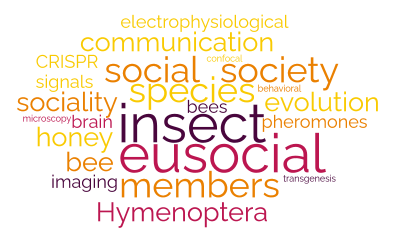
Assistant Professor University Paris-Saclay
Co-team leader of the Evolution & Behavior team
Tel: +33 1 69 15 49 73
Research

- Evolution of the olfactory and gustatory information processing in Hymenoptera
- Pheromone processing in the honey bee brain
Sociality is classified as one of the major transitions in evolution. The most advanced level of sociality is found in eusocial insect societies, and the insect order Hymenoptera presents the largest number of eusocial species and up to 8 independent origins of eusociality. The success of social insect colonies lies in the capacity of all members of the society to behave in a well-organized and context-dependent manner. But how does the superorganism of the colony coordinate its activities, allowing each individual to know which task to perform and when?


The composite organization of the honey bee society needs an elaborate way of communication among the colony members. Honey bees, the most intensely studied eusocial insect species, use a sophisticated means of communication through a high number of pheromones. How does the social insect brain manage to encode such a plethora of highly‐meaningful and ecologically‐relevant signals?
My research aims to answer this question using state-of-the-art techniques like in vivo optical imaging, electrophysiological recordings, CRISPR-Cas9 transgenesis, confocal microscopy and behavioral experiments.
Figures made by Rita Felix.
Publications
- Bastide H, Legout H, Dogbo N, Ogereau D, Prediger C, Carcaud J, Filée J, Garnery L, Gilbert C, Marion-Poll F, Requier F, Sandoz JC, Yassin A (2024) The genome of the blind bee louse fly reveals deep convergences with its social host and illuminates Drosohila origins. Current Biology, https://doi.org/10.1016/j.cub.2024.01.034
- Carcaud J & Sandoz JC (2023) Editorial overview: More than behavior and neurons. Current Opinion in Insect Science, doi: 10.1016/j.cois.2023.101037
- Carcaud, J., Otte, M., Grünewald, B., Haase, A.*, Sandoz, J.C.*, Beye, M.* (2023). Multisite imaging of neural activity using a genetically encoded calcium sensor in the honey bee. PLoS Biology, 21(1): e3001984, 1-20.
- Bestea L, Paoli M, Arrufat P, Ronsin B, Carcaud J, Sandoz JC, Velarde R, Giurfa M, de Brito Sanchez MG (2022) Unraveling the motivational secrets of honey bee foraging during the COVID pandemic. iScience 25(4):104116
- Bestea L, Briard E, Carcaud J, Sandoz JC, Velarde R, Giurfa M, de Brito Sanchez MG (2022) The short neuropeptide F (sNPF) promotes the formation of appetititve visual memories in honey bees. Biology letters, in press
- Bestea L, Paoli M, Arrufat P, Ronsin B, Carcaud J, Sandoz JC, Velarde R, Giurfa M, de Brito Sanchez MG (2021) The short neuropeptide F regulates appetitive but not aversive responsiveness in a social insect. iScience 25(1):103619
- Mertes M*, Carcaud J*, Sandoz, J.C. (2021). Olfactory coding in the antennal lobe of the bumble bee Bombus terrestris. Scientific Reports 11(1):10947 (*contribution égale)
- Bestea L, Réjaud A, Sandoz JC, Carcaud J, Giurfa M, de Brito Sanchez MG (2021). Peripheral Taste Detection in Honey Bees: What do Taste Receptors Respond to? European Journal of Neuroscience 54(2):4417-4444
- Mariette J, Carcaud J, Sandoz JC (2021). The neuroethology of olfactory sex communication in the honeybee Apis mellifera L. Cell and Tissue Research, 383: 177–194.
- Cholé H, Carcaud J, Mazeau H, Famié S, Arnold G, Sandoz JC (2019) Social contact acts as appetitive reinforcement and supports associative learning in honeybees. Current Biology 29(8): 1407-1413
- Bordiga P*, Cassel R*, Carcaud J, Simon F, Beraneck M, Le Gall A, Benoit A, Bouet V, Philoxene B, Besnard S, Watabe I, Pericat D, Hautefort C, Assie A, Tonetto A, Dyhrfjeld-Johnsen J, Llorens J, Tighilet B, Chabbert C (2019) Synaptic plasticity of vestibular primary synapses controls acute vestibular syndrome expression. (*contribution égale) Disease Models and Mechanisms 12(7)doi : 10.1242/dmm.039115
- França d Barros F, Carcaud J, Beraneck M (2019) Protocol for long-term visuo-vestibular mismatch in freely behaving mice. Journal of Visualized Experiments 144, e59135
- Carcaud J, Giurfa M, Sandoz JC (2018) Differential processing by two olfactory subsystems in the honeybee brain. Neuroscience 374:33-48
- Carcaud J, França de Barros F, Idoux E, Eugène D, Reveret L, Moore LE, Vidal PP, Beraneck M (2017) Long-lasting visuo-vestibular mismatch in freely-behaving mouse reduces the vestibulo-ocular reflex and leads to neural changes in the direct vestibular pathway. eNeuro 4(1):0290-16
- Juricek L*, Carcaud J*, Pelhaitre A, Riday TT, Chevallier A, Lanzini J, Auzeil N, Laprévote O, Dumont F, Jacques S, Letourneur F, Massaad C, Agulhon C, Barouki R, Beraneck M, Coumoul X (2017) AhR-deficiency as a cause of demyelinating disease and inflammation. Scientific Reports 7(1):9794 (*contribution égale)
- Carcaud J, Giurfa M, Sandoz JC (2016) Parallel olfactory processing in the honeybee brain: Odor learning and generalization under selective lesion of a projection neuron tract. Frontiers in Integrative Neuroscience 9:75, doi: 10.3389/fnint.2015.00075.
- Carcaud J, Giurfa M, Sandoz JC (2015) Differential combinatorial coding of pheromones in parallel olfactory subsystems of the honeybee brain. Journal of Neuroscience 35(10):4157- 4167
- Devaud JM, Papouin T, Carcaud J, Sandoz JC, Grünewald B, Giurfa M (2015) Neural substrate for higher-order learning in an insect: mushroom bodies are necessary for configural discriminations. Proceedings of the National Academy of Sciences USA 112(43): E5854-62
- Roussel E*, Carcaud J*, Combe M, Giurfa M, Sandoz JC (2014) Olfactory coding in the honeybee lateral horn. Current Biology 24 (5):561-567 (* contribution égale)
- Junca P, Carcaud J, Moulin S, Garnery L, Sandoz JC (2014) Genotypic influence on aversive conditioning in honeybees, using a novel thermal reinforcement procedure. PloS One 9(5):e97333
- Carcaud J, Hill T, Giurfa M, Sandoz JC (2012) Functional characterization of a dual olfactory pathway in the honeybee Apis mellifera. Journal of Neurophysiology 108:1106-1121
- Carcaud J, Roussel E, Giurfa M, Sandoz JC (2009) Odour aversion after olfactory conditioning of the sting extension reflex in honeybees. Journal of Experimental Biology 212:620-626
- Roussel E, Carcaud J, Sandoz JC, Giurfa M (2009) Reappraising social insect behavior through aversive responsiveness and learning. PloS One 4(1):e4197
